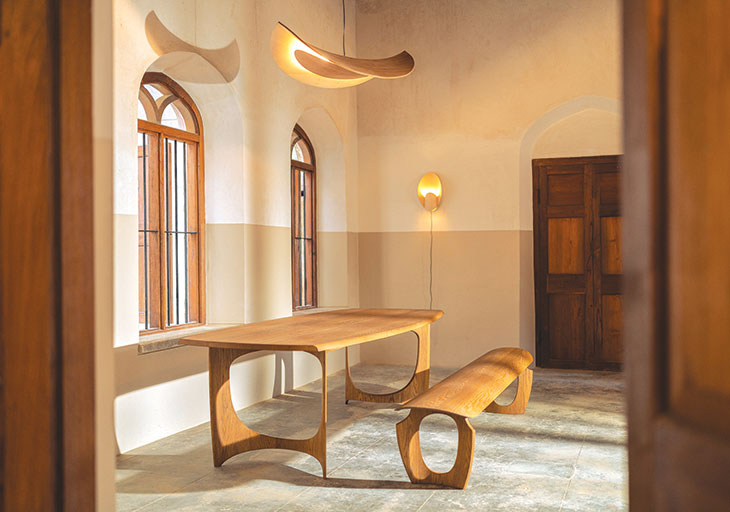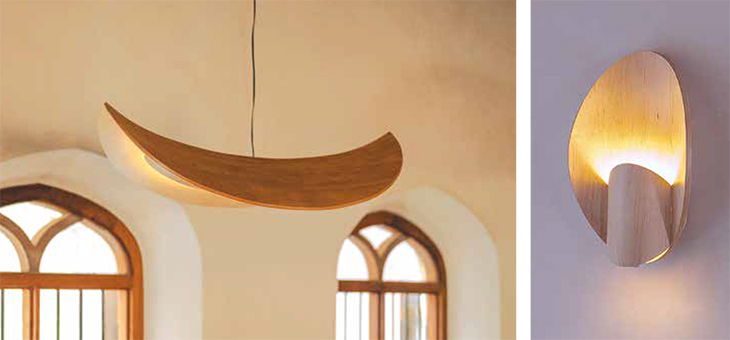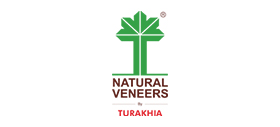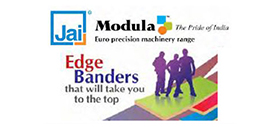A collaboration of craft and (woodworking) culture
Knowledge transfer was the key component of furniture and lighting design by Indian manufacturer, made in American hardwoods

The dining table, made from American red oak, is deceptively simple in structure, being two facing half-cylinders, which have been carved and shaped on-site at Phantom Hands’ factory in Bengaluru – with just a pencil, jigsaw and hand tools!
The recent BLR Habba (Bengaluru Festival), a two-week annual cultural event in the capital of Karnataka, offered an unusual experience this year in the form of a unique collaboration between a local bespoke furniture manufacturer, an Australian architect-designer and an American lumber supplier.
‘Refractions’, a cross-cultural, international design collaboration between Adam Markowitz, Architect and Founder of Melbourne-based Adam Markowitz Design, and Deepak Srinath, Co-Founder of Phantom Hands, came to life at Sabha BLR, a renovated and refurbished bungalow in central Bengaluru.
Phantom Hands makes hand-crafted, design-driven furniture rooted in Indian modernism. Their collections include re-editions of historically important mid-century designs, as well as contemporary objects created in collaboration with acclaimed furniture designers such as Inoda+Sveje, x+l, Derek Welsh, Klemens Grund, Big-Game and Nityan Unnikrishnan.
Commissioned by the American Hardwood Export Council (AHEC), the leading international trade association for the American hardwood industry, the collection made from American red oak, cherry and maple by Phantom Hands included a dining table, a bench, two pendant lights and a wall sconce.
Strength in curves
The dining table, made from American red oak, is deceptively simple in structure, being two facing half-cylinders, which have been carved and shaped on-site at Phantom Hands’ factory in Bengaluru – with just a pencil, jigsaw and hand tools!
According to Adam, two facing half-cylinders is the simplest way to make a table with curves. However, you can barely read the initial cylinder shape at all in the
final designs, as the hand work and sculpting has taken the form of art.
“The table concept is my favourite piece of the five. When the prototype was remade, I was asked to draw the shape in 3D so they (Phantom Hands) could reference it for cutting out the legs. I instructed them to use the prototype itself as the reference, because the shapes I had drawn and cut would be better than the shapes I drew on the computer.”
The Aussie-India team cross-laminated the veneer into plywood internally to reinforce the structure of the shape to give the piece additional rigidity. Both the seat and the legs are extremely thin and would never be able to take the structural loads if they were flat. The curvature and the laminating process allows these benches to become very strong with minimal material.
“I wanted to have seating to complement the table, and didn’t dare attempt a chair given the timeframe. American red oak was chosen for both the table and benches for its warmth, with a connection to mid-century oak pieces, for its strength in this structurally challenging application, and for the consistency of its grain and colour toning,” said Adam. Which meant that veneers could be readily matched.

The Banana Leaf pendant (L) intersects two petal shapes along their long edges, creating a curved central spine that is very strong. The wall sconce (R) takes the two petal shapes and intersects them face-to-face to create a surface which reflects the light.
Dialogue with light
The suggestion from Phantom Hands that it would be nice if there was a dialogue between the table and the lights, resulted in creation of two pendant lights and a wall sconce. The initial prototyping explorations were made with the circular offcut cut from the table leg – though the final pieces were ultimately made independently.
The cutouts resulted in two curved, petal-like shapes, which spoke to the Wood Rose starting point given to Adam by Aparna Rao, Co-Founder of Phantom Hands. The challenge lay in intersecting these two shapes in different ways to find shapes that were strong, elegant, and worked to conceal and reflect the light source.
The Banana Leaf pendant, named for its similarity to the fruit-bearing tree leaf, intersects two petal shapes along their long edges, creating a curved central spine that is very strong. Each petal shape then flows out from this central spine in a convex shape that diffuses the reflected light. A third petal shape, suspended below the intersecting petals, hugs the curved form above tightly and conceals the light source.
Similarly, the design approach to the Butterfly pendant rotates these petal elements and joins them along their short edge, to create two bower-like concave forms reminiscent of a butterfly’s wings to reflect and diffuse the light. A petal is inverted underneath, which again conceals the light sources.
“While the lights in cherry and maple have been finished to express their lovely natural tone, red oak is known for its porosity and excellent ability to be stained. I took the opportunity to work with Phantom Hands to explore colour options, something that is a frequent area of exploration in their other work,” Adam noted.
In addition to the pendants, the wall sconce takes the two petal shapes and intersects them face-to-face to create a surface which reflects the light, and a smaller shroud, which conceals the light source.
Here Adam expresses the intersectional quality of the design logic by showing the petal components passing through each other. This also creates opportunities to conceal wall mounting and wiring. Phantom Hands produced two wall sconces, a hard-wired version and a plug-in version.
One sconce was made with a blend of cherry and maple to match the pendant lights, and one sconce entirely in maple to really celebrate the qualities of this timber species on its own.
‘Carbon-negative’
The initial brief involved Adam being given a specific architectural space to consider as a starting point, with the aim of leveraging his specific set of skills. Phantom Hands was also aware of the work that Adam had done with bending and curvature in wood, and they were interested in learning more about those techniques.
Adam was asked to consider the Wood Rose, a unique flower, as a possible starting point. These formed the defining starting elements of the project and shaped the initial design process.
“My initial concern was to make sure that my work was imbued with an Indian-ness that was reflective of the collaboration and cultural exchange. Working closely with Phantom Hands, the collaboration became far more personal in nature,” Adam said. “Looking at the pieces, they are not something I would have arrived at working in isolation.”
The team at Phantom Hands collected data on the volumes of the three species used to make the five pieces. In total (and including wastage), 0.77 cubic metres of American cherry, maple and red oak were used.
The Rossi Group – a leading global producer of US hardwoods with extensive sorting, milling and drying capabilities in Pennsylvania and Connecticut – provided the project with the timber to experiment with. Rossi also connected the project partners to technical experts to help us learn about working with each of these species.
The environmental credentials of American hardwoods make them extremely attractive for Phantom Hands and the data on regeneration provided for each species helped it make clear decisions on which timbers to use in its future collections, said Srinath.
Through AHEC’s life cycle assessment tool, it was calculated that all of this wood would take just 1.72 seconds to be replaced in the American hardwood forests through natural regeneration, added Roderick Wiles, AHEC Regional Director. “We know that, on arrival in Chennai port, the American hardwood lumber that was donated by the Rossi Group, would have been carbon negative.”
Knowledge sharing
Said Deepak of the project: “AHEC understood that we wanted to be a part of the design process for the products that would get made in Bengaluru as part of the collaboration. They introduced us to Adam, with an open mandate to make anything we wanted to.”
What really helped was that Adam was a hands-on woodworker, with plenty of experience in working with American hardwoods. “Adam came to us with an open mind and the idea for the products came out of several conversations we had with him,” said Deepak.
Working remotely in Australia and then in person during his visits to Bengaluru, Adam was able to help the India team master methods for laminating timber, including techniques for sawing veneer and stitching veneer together into larger panels; methods of jig making for pressing veneers into shapes; and methods for gluing with clamps and a vacuum press.
Despite the language barrier, Adam was able to not only build a rapport with the team in India, but he also learnt a lot from watching them work and developed a deep respect for their hand skills stemming from their long craft tradition.
“Through collaborations like this, which involve passing on much-needed technical knowledge and hands-on experience, as well as showing the beauty, versatility and environmental credentials of American hardwoods, we hope to encourage more manufacturers in India to choose them,” concluded Roderick.
For more information, visit: www.americanhardwood.org, or follow on @ahec_india.
Comments

- ‘Red gazelle’ makes window installation easy
- Felder’s solutions for window and door production
- Versatile sliding-folding systems from Hafele
- Door line automation from Woodtech Consultants
- Accutec solutions for uPVC windows
- Jowat’s VOC-free primer for window profile wrapping
- Flexible solutions for doors, windows from SCM
- Tostem introduces Giesta steel doors; calls for dealers
- Folder system by Salice optimises cabinet space
- Turakhia has top-quality veneers for doors
- Mirka has solutions for difficult sanding of doors
- When Lamello’s Cabineo became a game changer
- Digital lacquer embossing for flooring from Hymmen
- Weber sanders help achieve luxury surfaces
- Hettich earns BIS nod for hinges, runners
- The importance of selecting the correct tools
- 3D is printing sustainable housing solutions
- Hard or soft? Researchers discover new wood type
- CLT shelter withstands severe seismic testing
- Japan World Expo gets largest wooden structure
- A collaboration of craft and (woodworking) culture
- ‘Reading consumer mindset is the key to success’
- PRECIOUS METTLE
- UF resin: blessing in disguise
- Cost savings for new factory investments
- ‘Natural’ is in, but efficiency is still at a premium
- What CAD, CAM software are best?
- Which drawer slides suit you best?
- First, back to the basics!
- Nolte Küchen has ₹17-cr plan for India expansion
- For compressed air, it’s Atlas Copco
- Häfele has fittings for all needs
- Holistic approach with Hettich’s magical solutions
- Salice’s Folder system optimises space
- WAF has two winning Indian entries
- Turkish designers delight with US hardwoods
- Decora joins hands with FFSC for skill academy
- Skill development comes to Udaipur’s furniture industry
- Forest management for sustainable supply from B.C. Canada
- New chapter in furniture innovation at CIFF 2025
- 3rd tech-together, exhibition at Hymmen
- imos organises Technology Day in Delhi
- Entries open for Interzum Awards 2025
- Ligna 2025 sees strong demand for participation
- MTC contest showcases creativity from wood waste
- TIWF 2024 concludes successfully
- Event-Calendar
- Egger’s ‘Capsule Concept’ creates harmonious décor
- Grass releases RAT system for cabinetry
- State-of-the-art edge bander from Jai
- SCM’s Balestrini centres for solid wood
- Sugatsune introduces new concealed hinge for doors
- Aryamman brings home Konrad Hornschuch products
- Automatic beam saw with twin pusher from Woodtech
- Seamless functional doors from Fiamarc
- Felder offers range of wide belt sanders
- OptiSaw 3.2 Panel Saw
- New guidelines to curb ‘green-washing’
- Ozone opens Experience Centre in Bengaluru
- Dieffenbacher takes over Schmidt & Heinzmann
- Egger invests in sustainability and automation
- Demand for American Oak soars in India
- Nitori to open first store in India
- Bureau Veritas acquires AI company
- Siempelkamp secures syndicated loan
- Merino to reduce carbon footprint
- Ebco’s new campaign features ‘Boom-Boom’ Bumrah
- SCM wins SMAU innovation award
- Unilin wins patent for flooring
- WhatsApp kicks off training for businesses
- SCM takes over Mecal Machinery
- Rajesh Mittal to head FIPPI
- Birla Opus opens fourth paints factory
- Greenply roots for ‘Pushpa 2’
- Wooden Street raises ₹354 cr. in funding
- Ashima Kaul recognized as top HR Leader









































